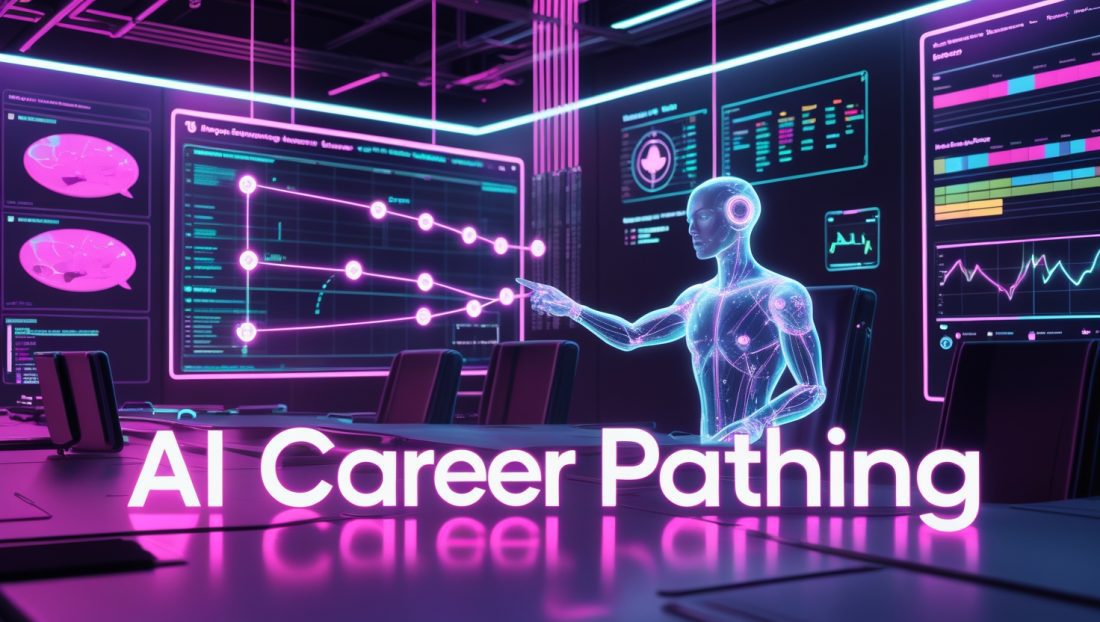The Silent Talent Crisis Eroding Your Competitive Edge
Why do 68% of high-potential employees leave organizations within five years? Sarah, a technology manager at Siemens Energy, nearly became part of this statistic. After three years without advancement, an AI career pathing system identified her untapped aptitude for renewable energy project leadership. It mapped a transition plan leveraging her existing systems expertise while adding strategic certifications. Within nine months, she filled a critical role that would have cost $300,000 in external recruitment.
This scenario reflects a pervasive reality: 85% of HR leaders report critical skills gaps in their workforce, while 44% of employee capabilities face disruption by 2028 (World Economic Forum). Static career frameworks collapse under technological acceleration and generational workforce expectations. AI career pathing evolves from experimental tool to operational necessity—transforming how organizations cultivate and retain talent. For a deeper dive into how AI is reshaping workforce strategies, explore why industrial AI implementation wins big in 2025 factories, which highlights AI’s role in optimizing operational efficiency.
The Structural Failures of Traditional Career Development
Conventional approaches crumble under modern workforce demands. McKinsey research reveals organizations relying on manual career planning experience 34% higher turnover costs and 50% longer leadership gaps. Three systemic flaws drive this crisis:
Hierarchical Rigidity
Linear promotion paths ignore cross-functional mobility. When Adobe analyzed career trajectories, they discovered employees with matrixed growth opportunities showed 2.1x longer tenure. Yet most corporate structures still silo talent within departments.
Skills Blind Spots
Manual skills inventories become outdated within months. Deloitte’s 2025 Global Human Capital Trends report states: “Only 29% of organizations accurately track workforce capabilities.” This opacity forces managers into reactive hiring rather than strategic development. To understand how AI-driven analytics can address such gaps, check out how AI-driven scientific discovery is transforming critical challenges, which showcases AI’s ability to uncover hidden insights.
Development Misalignment
Generic training programs waste resources. At Cisco, AI analysis revealed 62% of completed leadership courses didn’t align with employees’ actual career goals or organizational needs. The resulting disengagement cost an estimated $2.4 million annually in lost productivity.
Four AI-Driven Transformations Redefining Career Development
Precision Talent Mapping
AI algorithms convert fragmented data into actionable insights:
- IBM’s Watson Career Coach analyzes project histories, collaboration patterns, and skill certifications to identify role transitions with 87% accuracy.
- Unilever’s AI Pathfinder reduced critical role fill-time by 40% through predictive skills matching.
- Siemens Energy now sources 78% of leadership roles internally using AI-generated succession maps.
Dr. Elena Rodriguez of the HR Tech Institute observes: “These systems contextualize potential by connecting dormant capabilities to emerging business needs.” For a look at how AI enhances decision-making in other domains, see AI-driven model optimization strategies redefining business survival in 2025.
Predictive Workforce Resilience
Leading organizations forecast capability gaps before they cripple operations:
- Machine learning models cross-reference market trends with internal skill inventories to prioritize development. At Novartis, algorithms flagged coming regulatory biology shortages 18 months pre-crisis, enabling proactive reskilling.
- Behavioral analytics predict retention risks. By examining 200+ indicators—including project engagement patterns and learning platform activity—Ericsson achieves 91% accuracy in identifying flight risks.
Manager Augmentation
AI tools empower leaders as talent developers:
- TalentGuard’s Conversation Catalyst generates personalized development talking points based on individual skill profiles.
- Hilton’s promotion algorithms reduced gender bias in leadership nominations by 33% through continuous language monitoring.
- Grundfos eliminated traditional job descriptions entirely. HR Technology Architect Søren Nielsen states: “Skills-based architectures let us deploy talent dynamically across projects and roles.”
Fluid Talent Ecosystems
Internal marketplaces now drive strategic mobility:
- ServiceNow’s Talent Accelerator matches employees to stretch assignments based on verified competencies, not resumes.
- Deloitte measured 30% faster internal role transitions in organizations using AI-driven talent marketplaces.
- Cisco’s “Growth Hub” connects mentorship opportunities to career goals, increasing plan activation by 3x. To explore how AI fosters dynamic ecosystems in other industries, read about agentic AI in supply chain management, which illustrates autonomous decision-making for operational agility.
Navigating Ethical Implementation
Transparency Frameworks
GDPR-compliant systems must explain AI decisions. SAP SuccessFactors’ Talent Intelligence Hub shows employees: “This recommendation combines your Python certification and process optimization experience.” For insights into ensuring trustworthy AI, visit McKinsey’s AI Ethics Framework, which outlines best practices for ethical AI deployment.
Bias Mitigation Protocols
Regular algorithm audits prevent historical inequity replication. Microsoft’s Responsible AI checklist requires:
- Demographic parity testing in promotion suggestions.
- Third-party validation of skills assessment models.
- Human oversight flags for atypical patterns.
Vertisystem’s Ethics Advisory warns: “Technology should extend human judgment, not replace manager-employee relationships.”
Regulatory Alignment
The EU’s upcoming Artificial Intelligence Act mandates:
- Documentation of training data sources.
- Real-time opt-out options for employees.
- Impact assessments for high-risk HR applications.
For a broader perspective on AI regulation, check out the global AI regulation divide in 2025, which examines the challenges of aligning AI with legal frameworks.
Building Your AI Career Pathing Framework: A Practical Roadmap
Phase 1: Foundational Alignment (Weeks 1-6)
Skills Ontology Development
Map granular capabilities to roles. Deutsche Bank linked 12,000 positions to 600 defined skills, creating a dynamic taxonomy updated quarterly.
Data Integration
Unify HRIS, performance management, and learning systems. Schneider Electric’s API-first approach reduced implementation time by 50%.
Phase 2: AI Integration (Weeks 7-16)
Targeted Pilot Deployment
Focus on high-impact groups. Vodafone launched with tech teams, measuring:
- Time-to-proficiency in new roles.
- Retention of high-potential employees.
- Leadership pipeline depth.
Algorithm Selection Criteria
Prioritize explainable AI platforms. Key evaluation metrics:
- Bias detection capabilities.
- Integration flexibility.
- Real-time updating functions.
Phase 3: Adoption Scaling (Months 5-9)
Manager Enablement
L’Oréal’s certification program teaches:
- Interpreting AI recommendations.
- Connecting insights to development conversations.
- Balancing data with contextual awareness.
Employee Co-Creation
Accenture’s “MyPath” portal allows:
- Skill profile adjustments.
- Interest flagging for emerging roles.
- Feedback on recommendation relevance.
The Horizon: AI Career Pathing in 2026
Skills Blockchain Verification
Emerging systems like IBM’s Career Ledger create portable, tamper-proof skill credentials. Early pilots show 40% reduction in external hiring paperwork. Learn more about blockchain’s role in verification through blockchain-verified reforestation fixing carbon credit fraud.
Generative Development Coaching
Tools like Eightfold’s Deep Learning Coach simulate challenging leadership scenarios, providing real-time feedback during skill practice.
Predictive Learning Ecosystems
SAP’s Project Apollo dynamically curates micro-learning content when skills gaps are detected, reducing development time by 65% in trials.
Quantifying Inaction: The Cost of Delay
Organizations postponing AI career pathing implementation face measurable risks:
| Risk Factor | Financial Impact | Strategic Cost |
|---|---|---|
| Key Talent Attrition | 150-200% salary replacement | Leadership pipeline erosion |
| Skills Obsolescence | $1.3M per 100 employees | Competitive capability lag |
| Reactive Hiring | 32% higher acquisition costs | Cultural discontinuity |
McKinsey analysis confirms companies with mature AI career pathing show 34% higher revenue growth and 57% greater leadership bench strength.
Your Strategic Imperative

The convergence of workforce volatility and AI maturity creates an irreversible tipping point. As SAP’s Amanda Phillips asserts: “This transcends technology—it’s about operationalizing human potential at scale.”
Immediate Actions:
- Audit capability exposure using free assessment tools like Deloitte’s Skills Vulnerability Scanner.
- Prioritize pilot groups based on turnover risk and strategic importance.
- Establish cross-functional governance blending HR, legal, and operations leaders.
The organizations winning the talent war don’t merely adopt technology—they redesign development ecosystems around human aspiration and business necessity. AI career pathing provides the architecture for this transformation.

